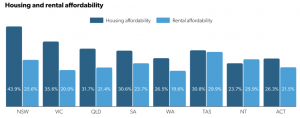Western Australia is once again the most affordable state in Australia for housing and rentals, according to the Real Estate Institute of Australia’s Housing Affordability Report.
Residential sales market
Although overall affordability declined in WA during the June 2021 quarter, WA remains the most affordable state in the country for housing, with only the Australian Capital Territory and Northern Territory more affordable.
The Housing Affordability Report shows the proportion of family income required to meet average home loan repayments in WA was 26.5 per cent in the June 2021 quarter, up from 26.3 in the March 2021 quarter and 25.4 in the June 2020 quarter.
There were 14,069 loans taken out in the June 2021 quarter in WA, which is a 106 per cent increase on the June 2020 quarter.
The average loan amount in WA during the quarter was $430,805. The average loan amount increased 2.9 per cent in WA during the quarter, which is significantly lower than other states like New South Wales and Victoria where the average loan amounts were $705,658 and $568,188 respectively.
First home buyers
First home buyers made up 44.2 per cent of the state’s owner-occupier market during the June 2021 quarter, which is the highest percentage of any state of territory in the country.
The number of loans to WA first home buyers declined slightly in the June quarter to 6,221, which is 94.6 per cent more than in the June 2020 quarter.
The average loan amount for first home buyers decreased 0.5 over the quarter and 3.7 per cent over the year to $368,028.
Rental market
WA is the most affordable place in the entire country to rent in and is the only place in the country that requires less than 20 per cent of a family’s average income to make repayments.
The June 2021 quarter Housing Affordability Report shows that the proportion of income required to meet median rent prices was 19.6 per cent, which is up slightly on the March 2021 quarter.
How the states and territories compare
The below graphic compares housing affordability in each state and territories’ owner-occupier and rental markets.

Sourced from REIWA

